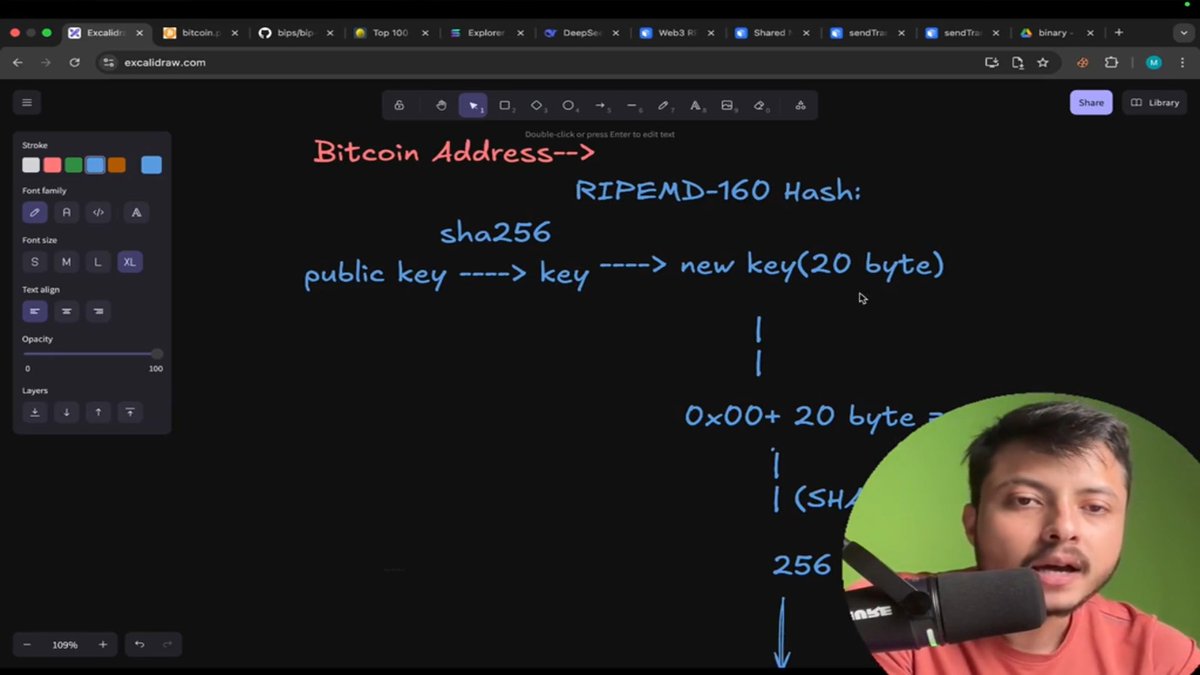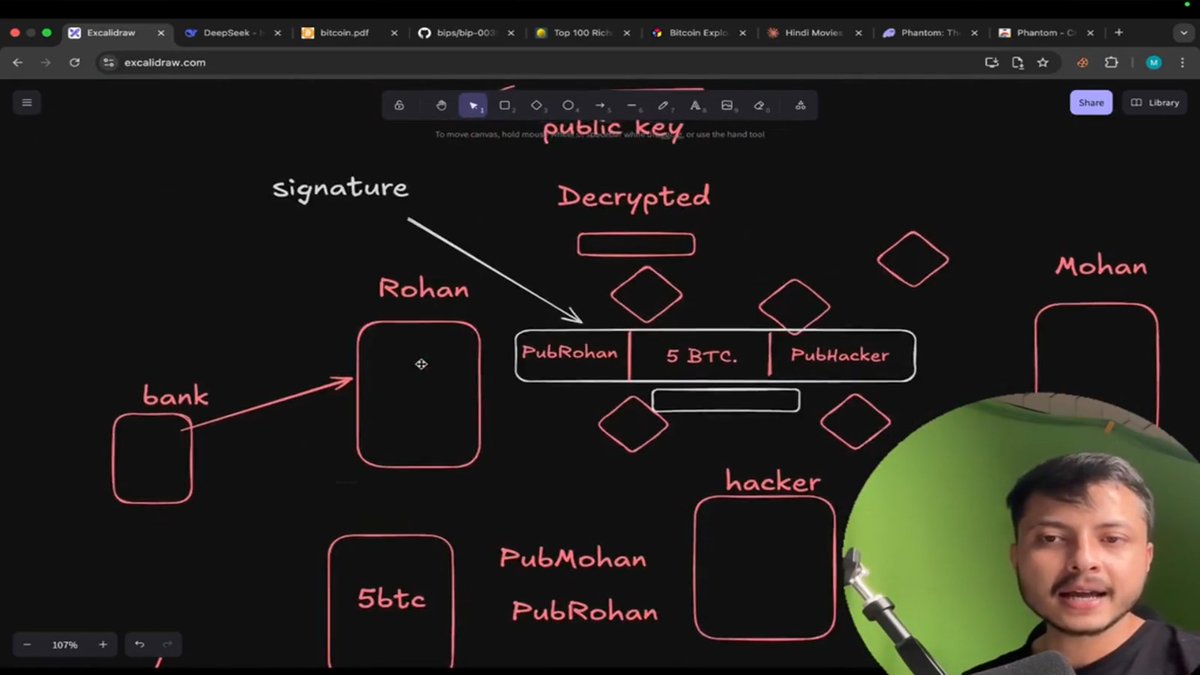
Jewel
@hridewel
Followers
111
Following
337
Media
92
Statuses
163
#Blockchain Day 14. • memory = temp, storage = permanent.• bytes[] = array of dynamic byte arrays.• State var default visibility = internal.• Modifiers run before/after via _.• Structs store data, not functions.• Checks state change = save gas. #Web3 #Crypto #Bitcoin #Nexus
0
0
3
#Blockchain Day 12. • msg.sender = caller address.• onlyOwner modifier for access control.• require() checks & reverts on failure.• payable functions accept ETH (msg.value).• .transfer() securely sends funds. #Web3 #Crypto #Solidity #Nexus #letsconnect
0
0
3
#Blockchain Day 12. • Bytecode ≠ original Solidity (compilation is 1 way).• Storage vs Memory vs Calldata.• State variables = permanent on-chain state.• 2/3 consensus stops tampering.• Slashing = burn 32ETH. #buildinpublic #Web3 #Ethereum #Solidity #Nexus #Blockchain
0
0
5
#Blockchain Day 11. • EOAs vs Contract Accounts.• Deterministic code = no random, no API calls.• Gas cost = optimize logic (O(√n) > O(n)).• Nonce.• Tx → EVM → updated global state.• State root hash = fingerprint of blockchain. #Web3 #Crypto #Ethereum #Nexus #letsconnect
0
1
12
#Blockchain Day 8. • Wallet keys generated locally.• Connect via JSON‑RPC endpoints.• ETH tx: construct, sign, broadcast, validate.• Solana addr = pubkey; quantum risk & PQC.• Notes on #notion n #hashnode. #letsconnect #Web3 #Crypto #Nexus
1
0
12
#Blockchain Day 6. • HD wallets = 1 seed → many keys.• Master key + chain code → key tree.• New addr for every txn = more privacy.• Address = hashed public key (not private).• Notes on #notion n #hashnode. #letsconnect #Web3 #Crypto #Bitcoin #Nexus
1
0
8
#Blockchain Day 5. • UTXOs = unspent outputs, not balances.• Must spend full UTXO, get change back.• SPV wallets use block headers + Merkle proof.• No full blocks needed.• Lightweight but secure.• Notes on #notion n #hashnode. #letsconnect #Web3 #Crypto #Bitcoin #Nexus
0
0
7
#Blockchain Day 4. • Blocks store hash of prev block.• Chain breaks if 1 block changes.• Longer chain = accepted chain.• 51% attack = majority wins.• Security via math, not trust.• Notes on #notion n #hashnode . #letsconnect #Web3 #Crypto #Bitcoin #Nexus
1
0
6
#Blockchain Day 3. • Mempool = waiting room for txns.• Miners pick txns with the highest fees.• Nonce = guesswork, not magic.• PoW = brute force until hash fits.• 14-day cycle = dynamic difficulty.• Notes on @NotionHQ n @hashnode. #letsconnect #Web3 #Crypto #Bitcoin #Nexus
0
0
6
#Blockchain Day 2. • Miners ≠ Banks: validate, not control.• One block ≠ one txn.• Why changing 1 block breaks the chain.• Hash links = tamper-proof history.• Proof of Work = real skin in the game.• Immutable ledger = trust code. #Web3 #Crypto #Bitcoin #Nexus #letsconnect
0
0
7
#Blockchain Day 1. • Evolution: Barter → Digital Currency.• Why the USD became the reserve currency.• 2008 crash & centralized risk.• Inflation vs Deflation.• Birth of Bitcoin = Trust Crisis Fix.• Why decentralization matters!. #letsconnect #Web3 #Crypto #Bitcoin #Nexus
0
0
11
Just got the @LeetCode June Batch! . Let’s make every problem count! 💪 . #letsconnect #dsa #LeetCode #CodingJourney
1
0
9
Today's POTD on @LeetCode. Approach: Sort nums, use two pointers. If nums[left] + nums[right] <= target, count 2^(right-left) subsequences. Move pointers accordingly. TC: O(n log n). SC: O(n). #letsconnect #DSA
1
0
6
Hi! I’m looking forward to #connect with people who are interested in :-. 👨💻 DSA.💻 Leetcode.💼 MERN Stack.⛓️ Blockchain.✅ Software Development. #letsconnect n grow.
72
0
100
Today's POTD on @LeetCode. Approach: Traverse nums and for every index i where nums[i] == key, mark indices from max(mini, i - k) to min(n-1, i + k) as valid. Use mini to avoid duplicate entries. TC: O(nk). SC: O(n). #letsconnect #DSA
1
0
9
#React Day 8 ⚛️. • React Router dynamic routes.• useParams Hook.• Optional chaining (?.) in JSX.• Multiple GitHub user cards.• Custom hook for fetching profiles.• Handling param changes.✅ Notes on #Notion . #ReactJS #WebDev #100DaysOfCode #JavaScript #Nexus
0
0
6
Today's POTD on @LeetCode. Approach: Traverse the string in steps of k, use substr() to extract chunks. If the last part is shorter than k, pad it with fill until length k. TC: O(max(n, k)).SC: O(n). #letsconnect #DSA
1
0
7























































